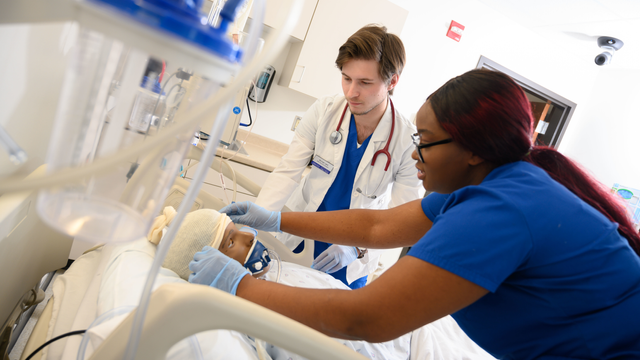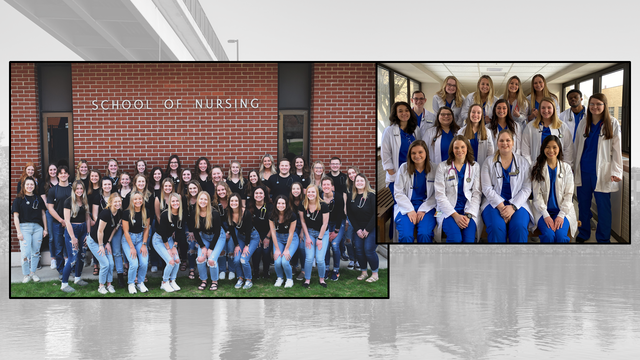WISYS Quick Pitch
Woodland Theater
Tuesday, April 30
4:30-6:30pm
Summer Georganne Peoples, Shawna Renee Helmuth, and Madisyn Joy Kephart, from Nursing, presenting on: “Maternal Exposure to PM2.5 During Embryonic Cardiac Development Leads to Hypoplastic Left Heart Syndrome: A Hypothesis Generated through the IMPACT Program” Mentor: Jeanette Olsen
Domestic Immersion Presentations
Centennial Room
Wednesday, May 1
9:00-9:50am
Companeros en Salud y Seguridad/Partners in Health and Safety
Anna Bachmeier, Cassandra Buerger, Amaris Vesely Faculty Mentor/Collaborator: Lisa Schiller
For 7 days during the fall and spring semester, UW-Eau Claire Nursing students travel to large dairy farms in Western Wisconsin to provide screenings, immunizations, and education to mostly Latino farm workers. Students integrate knowledge of agricultural health and safety, and an understanding of rural and Latino culture into their nursing practice, by providing on-site education and basic health screenings. The program includes preparation in collaboration with partners, culturally sensitive services to farm workers, and debriefing sessions upon completion of the experience.
Poster Student Presentation
Ojibwe Ballroom
Wednesday, May 1, 4:00 - 6:00pm
Thursday, May 2, 2:00 - 4:00pm
KINESIOLOGY AND NURSING
Effectiveness of a social media discussion board on strength training adherence and self-efficacy in novice college aged females
Karina Wait, Madeline Norman, Faculty Mentors/Collaborators: Saori Braun, Der-Fa Lu
Poster #: 141
The purpose of the study was to examine the effectiveness of a private social media discussion board on strength training confidence levels/adherence in college females during a six-month intervention. The secondary aim was to examine the effect of strength training on percent body fat and fasting blood glucose. Methods: Participants were randomly assigned to: 1) social media/exercise (SME; n=4), 2) social media only (SM; n=3); 3) exercise only (E; n=3); and 4) waitlist/control (C; n=3). Participants in the SM and SME groups were placed into two separate closed chat groups and engaged in two weekly postings. All participants completed a weekly Qualtrics survey every Monday about confidence level and number of days of strength training during the previous week. E and SME groups were given a six-month resistance training program with a focus on the seven major muscle groups. Results: There was a significant increase in strength training frequency across all groups during the first week but no difference in confidence levels from week 0 to week 1 and week 0 to week 9/11. A significant increase in confidence levels occurred over 14 weeks. Findings suggest that future research needs to focus on maintaining frequency and participant engagement.
LANGUAGES AND NURSING
Transcultural Nursing Care within the Chippewa Valley Amish Community
Benjamin Peterson, Cassandra Plachetka, Faculty Mentors/Collaborators: Joshua Brown, Norah Airth-Kindree
Poster #: 13
Within the United States, Wisconsin contains the fourth largest population of Amish people. Amish communities in Wisconsin continue to grow in numbers, in fact, Wisconsin has had the largest number of new Amish settlements every year since 2000. With more Amish in the state than ever before, understanding the unique culture of the Amish is vitally important, especially in health care. The purpose of this collaborative project involving the Eau Claire City-County Health Department and the UW-Eau Claire Departments of Nursing and Languages is two-fold. First, local healthcare providers will be educated on local Amish health care practices to provide culturally-sensitive care. In order to provide the highest level of culturally sensitive care, a comprehensive understanding of Amish culture and beliefs is integral. Second, local resources will be complied for local Amish communities as well as the health care organizations that serve them. The resources focus on select health care issues pertinent to the local Amish community as identified by the Eau Claire City County Health Department.
COLLEGE OF NURSING AND HEALTH SCIENCES
Maternal Exposure to PM2.5 During Embryonic Cardiac Development Leads to Hypoplastic Left Heart Syndrome: A Hypothesis Generated through the IMPACT Program
Summer Peoples, Shawna Helmuth, Madisyn Kephart, Faculty Mentor/Collaborator: Jeanette Olsen
Poster #: 72
Congenital heart defects are present in about 1% of all live births. Within that 1%, the incidence of hypoplastic left heart syndrome (HLHS) ranges from 4.8% to 9%. In utero, the heart begins to develop around week three of pregnancy, and early cardiovascular system development is complete at the end of week eight. Current research suggests that HLHS may be genetically complex, inheritable, and likely linked to teratogenic drugs and environmental and seasonal influences. Particulate matter (PM) has dangerous effects during embryonic cardiac development. PM2.5 is small enough to enter the bloodstream, cross the placenta, and access fetal circulation. High levels of PM2.5 in the blood cause biomarkers of oxidative stress, which are similar to those found in HLHS. PM2.5 levels are highest in urban areas, especially during winter months. Seasonal trends indicate the incidence of HLHS is higher during summer months. Consequently, we hypothesize HLHS is caused by maternal exposure to high levels of PM2.5 in the atmosphere during embryonic cardiac development. Blood levels of PM2.5 should be tested during pregnancy and compared with postpartum blood analyses to test this hypothesis. With a high mortality rate and costly hospital stay, our hypothesis focuses on a preventative action for HLHS.
Developing Professionalism and Communication Through Acute Care Nursing Simulation
Chelsea Scholbe, Faculty Mentor/Collaborator: Meg Lagunas
Poster #: 53
The educational value of simulation has been demonstrated in areas such as standardized student practice, student confidence, and psychomotor skills (Cantrell, Franklin, Leighton, & Carlson, 2017). However, little is known about how simulation can be used to improve and develop other areas of student learning necessary for a successful career such as communication and professionalism. This study aims to explore if simulation provides effective and realistic opportunities to practice professionalism by measuring if; 1) students can provide family centered care, 2) students can participate in effective interprofessional communication, 3) students can critically reflect on the professional concepts being practiced, 4) students value practicing professionalism concepts in simulation. University of Wisconsin-Eau Claire nursing students participated in the simulation during their senior pediatric clinical. The simulation is designed for two students to participate at a time: one student cares for the child until he is brought into surgery and the other student cares for the child post-operatively. Both students observe through a two-way mirror and write feedback to their peer when they are not caring for the child. Preliminary results suggest that simulation is an effective and realistic method to practice professionalism and communication.
Using Action Research to Develop a Faculty/Student Educational Program for Addressing Incivility in Nursing Education
Hannah Sisto, Kristin Brunsell, Rebecca Wickler, Faculty Mentors/Collaborators: Jeanette Olsen, Shelley-Rae Pehler, Rita Sperstad, Rachel Merkel, Linda Sargent
Poster #: 52
The aim of this project was to prepare nursing students, faculty and staff to address incivility by identifying, developing, implementing and evaluating a quality improvement educational program to address incivility among undergraduate nursing students and faculty. Incivility is recognized as a serious issue in nursing education including in the UW-Eau Claire College of Nursing. A 2017-2018 faculty/student research project indicated 38% students and 50% of faculty consider it a moderate to serious problem. To address this issue, a team of faculty and student co-researchers used action research methodology to develop "Creating a Culture of Civility", a two-part civility training offered to nursing students and faculty. The first portion involved an E-learning module containing education on definitions, perceptions, and recognition of incivility, along with opportunities for reflection. The second portion involved a two hour face-to-face civility training that used role-play simulations with small and large group debriefing to equip students and faculty with skills for responding to incivility. An evaluation survey of both the E-learning and face-to-face sessions inform the outcomes of the quality improvement project and provide feedback on the knowledge and communication skills participants gained for use when faced with uncivil situations. Plans for sustainability will be discussed.
Evaluating Community Chronic Disease Prevention Efforts in a Rural Midwest County
Amaris Vesely, Faculty Mentor/Collaborator: Jeanette Olsen, Barron Co. Public Health Collaborator: Laura Sauve
Poster #: 73
One in three adults has prediabetes and almost 30% have hypertension. Early identification and lifestyle changes can prevent disease progression. In 2013, a rural Midwest county formed a team with public health nurse leadership and representation from three competing healthcare organizations to increase awareness of prediabetes and hypertension through media and educational strategies and health screenings. The purpose of this community-based research project was to conduct a five-year evaluation of their efforts. Media and educational strategy data were collected by a survey of team members and observation on websites and in facilities, the most common strategy being social media and news releases or ads. Five years of de-identified health screening data were analyzed descriptively. The mean age of the 3090 participants was 60.27. Most were overweight or obese (70.3%). Fasting glucose results indicated 27.8% may have been newly identified with prediabetes (n=796) or diabetes (n=63). Blood pressure results indicated 354 new hypertension cases may have been identified. These interventions attracted mostly older, overweight adults, a group at high risk for diabetes and hypertension. Public health nurses are optimally positioned to promote population-level, collaborative chronic disease prevention efforts that generate cooperation among competing healthcare organizations and leverage resources in rural areas.
Forgiveness: Therapeutic Booklists and Playlists
Craig Walther, Faculty Mentor/Collaborator: Ann Recine
Poster #: 83
Nurses need forgiveness intervention tools because forgiveness affects their patients’ health. The goal of this project was to review peer-reviewed literature to discover what lists of books or other media help people to forgive. Bibliotherapy utilizes narrative in the form of fiction, biography, theology, etc., for therapeutic effect. There is limited information on how to build targeted book or media lists to help people forgive. We searched databases, using the search terms, “bibliotherapy”, “forgiv*”, “media”, “qualitative”, and “quantitative” to answer our research question: What reading material and mass media helps people forgive? Our research indicates that while scholars have developed processes that help people forgive, none developed lists of narrative or didactic literature that helped people forgive. We also found that intentionally modeled behavior, broadcast as a radio drama, encouraged the forgiveness process in areas of the Democratic Republic of Congo. These findings connect to research conducted by Albert Bandura, who showed that behavior modeled by others is one way that encourages people to change their own behavior. This research revealed gaps in the scholarly literature to answer our research question, therefore this literature review is the first step in the development of a qualitative study to fill this gap.




